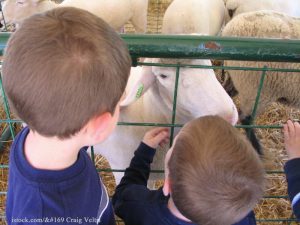It’s state fair time! State fairs around the country are in full swing. Some have ended, and some have yet to begin. These gatherings are celebrations of the harvest and of the hard work of farmers. But in the past, these fairs and other late summer and early fall gatherings have been the source of dangerous E. coli outbreaks.
 This year, an E. coli O157 outbreak at the Minnesota State Fair has sickened 11 people, hospitalizing six. One person has developed HUS. Most of the patients visited the Miracle of Birth exhibit, and had contact with ruminant animals.
This year, an E. coli O157 outbreak at the Minnesota State Fair has sickened 11 people, hospitalizing six. One person has developed HUS. Most of the patients visited the Miracle of Birth exhibit, and had contact with ruminant animals.
Earlier this year, a deadly E. coli outbreak at the San Diego County Fair sickened 10 people. Three people were hospitalized and one 2-year-old died.
In 2014, an E. coli O157:H7 outbreak linked to the traveling Zerebko Zoo Tran petting zoo sickened at least 13 people. The fair traveled to the Rice County Fair, the Nashwauk 4th of July Festival, the Polk Country Fair, and the Olmsted County Fair.
In October 2013, three children at Dehn’s Pumpkins in Dayton, Minnesota were sickened with E. coli infections. One child in that outbreak developed hemolytic uremic syndrome (HUS) and was hospitalized for weeks.
And in 2012, 106 people were sickened with E.coli infections after they visited a petting zoo at the Cleveland County Fair in North Carolina. One child died in that outbreak. Afterwards the Cleveland County Fair decided against having a petting zoo at their event.
Ruminant animals, such as cows and goats, carry E. coli bacteria in their guts and do not appear sick. That bacteria can get onto the animal’s hide after they defecate. When children touch or pet these animals, they can pick up the bacteria on their hands. And children constantly put their fingers in their mouths.
Barns where animals are shown can also be contaminated with pathogenic bacteria. After a visit to the Milk Makers Fest at the Northwest Washington Fairgrounds in Lynden, Washington, at least 25 people were sickened with E. coli O157:H7 infections. Ten children were hospitalized. Investigators found the outbreak strain of bacteria at four locations at the festival.
Hand washing stations can be few and far between at these fairs and festivals. Even if they are present, with warning signs admonishing fairgoers to scrub up after leaving a barn, many people will ignore them. Then, when they eat cotton candy or a corn dog, they can ingest the bacteria and get sick.
The symptoms of an E. coli O157:H7 infection include severe stomach and abdominal cramps, diarrhea that is usually watery or bloody, and a mild fever. The symptoms begin 2 to 5 days after exposure, and the illness lasts 7 to 10 days.
About 5% of E. coli O157:H7 infections lead to hemolytic uremic syndrome (HUS), especially in children under the age of 5. This serious complication can destroy the kidneys and cause strokes, pancreatitis, heart problems, and death. About 5% of HUS cases are fatal. The symptoms of HUS include low or no urine output, pale skin, easy bruising, decreased consciousness, jaundice, and skin rash. If any child develops these symptoms, immediate medical attention is critical.
If you or any member of your family has visited a state, local, or county fair or festival this summer, and has experienced the symptoms of E. coli poisoning, see your doctor. Early treatment is essential for a good outcome. Treatment with antibiotics, unfortunately, increases the chances that the illness will develop into HUS. A stool test will determine if the illness is E. coli.
After all it is state fair time. If you do go to a fair, be careful. Stay away from the barns if you have young children, are pregnant, are elderly, or have a chronic illness or compromised immune system. If you go to the barns or visit a petting zoo, keep a close eye on the kids. Make sure they do not touch their faces after petting animals, and make sure they wash their hands thoroughly with soap and clean running water after they visit animals. Keep your fair visit safe. And fun.




